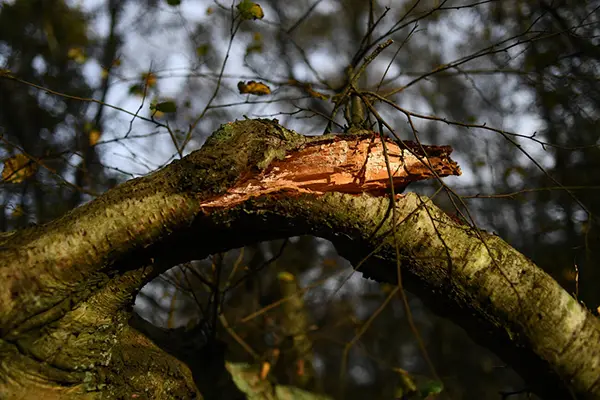When it comes to assessing whether a tree poses a danger and needs cutting, there are several key factors to consider. You should look for signs of health decline, such as wilting leaves or dead branches.
Structural stability is also crucial; a tree leaning too much or showing cracks can indicate trouble. But that’s just the start—understanding environmental influences can make a big difference in your assessment.
What else should you be on the lookout for?
Signs of Tree Health Decline
Noticing changes in a tree’s appearance or growth is crucial to identifying potential health issues. Early detection can help prevent further damage or safety risks, and it often requires attention to detail.
Key Indicators of Tree Health Issues
- Wilting or Discolored Leaves: Leaves that become wilted, yellow, or show unusual spots may indicate a problem, such as nutrient deficiencies or disease.
- Unusual Leaf Drop: Excessive shedding of leaves, especially outside the usual season, could signal stress or pest infestations.
- Bark Issues: Cracking, peeling, or flaking bark is a clear sign that the tree may be under stress, possibly from disease or injury.
Potential Signs of Internal Problems
- Fungal Growth: Fungus growing on the trunk or at the tree’s base is a strong indicator of internal rot or other forms of decay.
- Stunted or Uneven Growth: If the tree isn’t growing as expected or shows uneven growth, it may be struggling with environmental stress, pests, or disease.
Dead Branches and Lack of New Growth
- Dead Branches: Dead or dying branches are not only unsightly but can also be a sign that the tree’s health is declining.
- Lack of New Growth: If the tree isn’t producing new shoots or leaves during the growing season, it could be a sign of poor health or a weakening root system.
What To Do Next
- Monitor the Tree: Regularly check for any of these signs to track the tree’s health.
- Seek Professional Help: If you notice several symptoms, contact a professional arborist for evaluation and guidance.
Catching early signs of tree decline can prevent further damage and help keep your landscape safe and thriving.
Structural Instability Indicators
A tree’s structural stability is crucial to ensuring the safety of your property. Certain signs can indicate that a tree is at risk of falling or becoming a danger.
Visible Cracks or Splits
- Trunk Cracks: Look for large cracks or splits in the tree’s trunk, as they can weaken the structure and lead to failure, especially during storms.
- Visible Cavities: Cavities or hollow sections in the trunk are signs of decay and can reduce the tree’s ability to bear weight.
Leaning Trees
- Leaning More Than 15 Degrees: A leaning tree may indicate root damage or soil erosion, which can lead to instability. Pay close attention to any tilting that becomes more pronounced over time.
Signs of Decay and Rot
- Mushroom-Like Growths: Fungi, like mushrooms, growing at the base of the tree often point to internal decay or root rot.
- Dead or Missing Branches: Large, dead branches or missing limbs suggest that the tree may be deteriorating, reducing its overall stability.
Root System Issues
- Exposed or Damaged Roots: Roots that are exposed or have suffered damage can compromise the tree’s stability, making it more likely to fall.
- Heaving Soil: Soil around the base of the tree that has shifted or is lifting can indicate that the roots are no longer secure in the ground.
Pest Infestations
- Signs of Insects: Insects like termites or carpenter ants can damage a tree’s core structure, weakening its overall integrity. Look for visible holes or insect trails in the trunk or limbs.
What To Do Next
- Assess and Monitor: Regularly check for these structural instability indicators, especially after storms or high winds.
- Consult an Arborist: If you notice any of these signs, it’s advisable to consult a professional arborist who can assess the situation and recommend any necessary actions.
Being aware of these indicators can help you act before a tree becomes a safety hazard, ensuring your property remains secure.
Environmental Factors Affecting Tree Safety
Environmental conditions play a significant role in a tree’s overall safety. Weather, soil quality, construction, and pests can all influence the health and stability of your trees.
Weather Conditions
- Heavy Rain: Excessive rainfall can saturate the soil, weakening the root system and making the tree more susceptible to uprooting.
- Strong Winds: High winds, especially after storms, can cause branches to snap or trees to topple, particularly if the root system is already compromised.
Soil Quality and Drainage
- Poor Drainage: Trees in areas with inadequate drainage are prone to root rot, which can affect their stability.
- Nutrient-Deficient Soil: Lack of essential nutrients can weaken a tree’s growth and make it more susceptible to diseases and pests, ultimately compromising its structural integrity.
Nearby Construction or Excavation
- Root Disruption: Construction projects or excavation work close to trees can disturb their root systems, limiting the tree’s access to water and nutrients.
- Soil Compaction: Heavy machinery can compact the soil around trees, restricting root growth and increasing the risk of tree instability.
Pests and Diseases
- Infestations: Pests, like termites or carpenter ants, can hollow out the tree’s trunk and branches, weakening its structure.
- Diseases: Fungal infections or bacterial diseases can cause internal rot, further compromising the tree’s health and safety.
What to Do Next
- Regular Inspections: Regularly assess environmental factors that could impact your tree’s health, especially after severe weather or nearby construction activities.
- Consult an Arborist: If you suspect environmental factors are affecting the health or stability of your tree, consider seeking professional advice from an arborist to identify and address potential risks.
Understanding the environmental factors affecting your trees allows you to stay proactive, ensuring their safety and preventing hazards before they arise.

